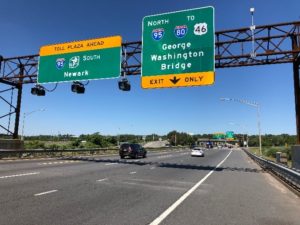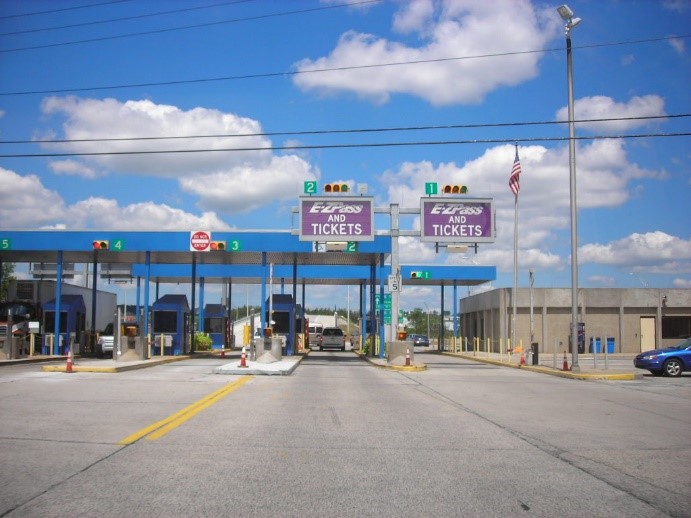By Shelia Dunn, NMA Communications Director
Despite NMA and public opposition plus general condemnation for holding hearings during a pandemic, the New Jersey Turnpike Authority voted unanimously on May 27 to increase tolls on two of the state’s largest toll roads. The increase takes effect on September 13, 2020, and would increase the average Turnpike toll for passenger vehicles to $1.30, and the Garden State Parkway toll increase would rise 40 cents from $1.50 to $1.90.

The additional money will be used to pay for a $24 billion capital plan that includes widening sections of both the Turnpike and Parkway and replacing a bridge between New Jersey and Pennsylvania. The toll increases would also allow the Authority to implement cashless tolling permanently.
Speaking of cashless tolling, the Pennsylvania Turnpike Commission announced in early June that it would implement cashless tolling almost immediately and lay off about 500 toll workers (roughly half the commission’s total workforce) in the process. Initially, the plan was to switch to cashless tolling late 2021, but since March, due to the COVID-19 crisis, the commission stopped accepting cash—which was hailed as a temporary measure.

Cash tolls won’t come back at all, and instead, tolls will be assessed electronically either by E-ZPass or Toll by Plate. In mid-May, the commission announced turnpike traffic dropped 50 percent (20 million fewer vehicles) since March. Toll revenue went down nearly $150 million in the same period.
Ironically, the commission announced two weeks before that nearly 1,400 union Turnpike workers would receive a raise. The agreement also established a severance package for toll collectors who may lose their jobs when the Turnpike goes cashless in the fall of 2021. Unclear whether this agreement signed before will still apply for the new arrangement.
In Philadelphia and Pittsburgh, PennDOT officials have been discussing congestion pricing as a potential funding mechanism. Acting PennDOT Secretary Yassmin Gramian said that the department was ‘intrigued by the potential for congestion pricing,’ even before the COVID-19 Crisis.
This is the issue: PennDot receives $400 million in annual fund transfers from the Turnpike Commission to support mass transit. Due to the economic slump, unclear whether the Turnpike can afford to send this cash PennDOTs way. In the meantime, PennDot is looking at its budget hole of $900 million due to less gas tax funding. In a 2019 Report, a congestion pricing plan could likely bring in upwards of $200 million for the state.
Fun times ahead for both states and her drivers.
Here are six other top Tolling in America stories from the past weeks:
- War on Cars Watch: Congestion Pricing in the US–ENO Center for Transportation Report
- Tolling Industry Wants $9.2 Billion Taxpayer Bailout
- Toll Road Extension through San Clemente, CA Shot Down, Maybe Forever
- Illinois Tollway collections down $52 million in April due to pandemic
- Why do we have HOV lanes in Las Vegas?
- Texas: SH 130 offers half-price overnight truck tolls in June

NMA also has resources that might help in local efforts to fight tolls and fight for proper funding of infrastructure.
- NMA Tolls Issue Page
- NMA Principle Number 6: Reasonable highway user fees for maintaining and improving highways, not for financing non-highway projects
- E-ZPass is Anything But: A Motorist’s Viewpoint
- Paying More for Less Service: NMA E-Newsletter #534
- Some numbers to chew on
- Is an Infrastructure Apocalypse on the Horizon?
- Taking Tolling to Task: NMA Weekly E-Newsletter #480
- No More Toll Roads
- Congestion Pricing Cannot be the Future of Transportation Funding, Part 1: NMA E-Newsletter #468
- Congestion Pricing Cannot be the Future of Transportation Funding, Part 2: NMA Weekly E-Newsletter #469
Want to keep track of the many issues currently involved in tolls and other infrastructure funding? Take a daily peek at the NMA’s Driving News Feed or subscribe to Driving News Daily, a five times per week email.
If you would like to support the work of the National Motorists Association, please join today.
Thank you for reading the NMA’s Tolling in America Blog!






